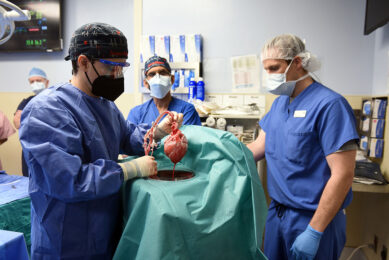EU pig identification rules tightened
An EU Council Directive has been adopted calling for stringent new standards for pig identification and registration.
The new directive builds on multiple amendments to existing veterinary legislation, and requires member states to ensure tight control over records of pig numbers and animal movements.
Up-to-date lists
Competent member state authorities are required to keep up-to-date lists of all the holdings where pigs are reared, as well as specifying the keepers. Member states are also obliged by the directive to ensure that all pig keepers on this list maintain a register detailing the number of animals present on the holding.
The register should additionally include an up-to-date record of movements, stating as appropriate the origin or destination of pigs at the holding, and the date of such movements.
Keepers are also required to supply “all information concerning the origin, identification and, where appropriate, the destination of animals which he has owned, kept, transported, marketed or slaughtered”.
Marking requirements
Procedures for ensuring no pigs are unmarked and unaccounted for are also the subject of new precisions.
The member state list of holdings must include the marks on the animal which identify the individual holding, until three consecutive years have elapsed with no animals on the holding.
The directive also states that identification marks must be applied before animals leave the holding of birth, with an eartag or tattoo referencing their holding of origin.
This also applies to any animal imported from a third country, which need to be marked within 30 days of veterinary checks — and in any event before being transported away from the first holding.
Exceptions
Up-to-date lists
Competent member state authorities are required to keep up-to-date lists of all the holdings where pigs are reared, as well as specifying the keepers. Member states are also obliged by the directive to ensure that all pig keepers on this list maintain a register detailing the number of animals present on the holding.
The register should additionally include an up-to-date record of movements, stating as appropriate the origin or destination of pigs at the holding, and the date of such movements.
Keepers are also required to supply “all information concerning the origin, identification and, where appropriate, the destination of animals which he has owned, kept, transported, marketed or slaughtered”.
Marking requirements
Procedures for ensuring no pigs are unmarked and unaccounted for are also the subject of new precisions.
The member state list of holdings must include the marks on the animal which identify the individual holding, until three consecutive years have elapsed with no animals on the holding.
The directive also states that identification marks must be applied before animals leave the holding of birth, with an eartag or tattoo referencing their holding of origin.
This also applies to any animal imported from a third country, which need to be marked within 30 days of veterinary checks — and in any event before being transported away from the first holding.
Exceptions
Exceptions to this are only permitted if pigs are being transported directly to a slaughterhouse within the member state territory, for slaughter within 30 days.
The new directive will operate in tandem with more detailed rules established in the porcine sector for disease eradication and control purposes.
Alongside identification and traceability concerns, existing animal health requirements ensure that a harmonised veterinary health certificate is provided prior to any intra-Community dispatch of pigs, with additional certification required if the destination is an assembly centre or market.
Subscribe here to the Pig Progress newsletter
The new directive will operate in tandem with more detailed rules established in the porcine sector for disease eradication and control purposes.
Alongside identification and traceability concerns, existing animal health requirements ensure that a harmonised veterinary health certificate is provided prior to any intra-Community dispatch of pigs, with additional certification required if the destination is an assembly centre or market.
Subscribe here to the Pig Progress newsletter











